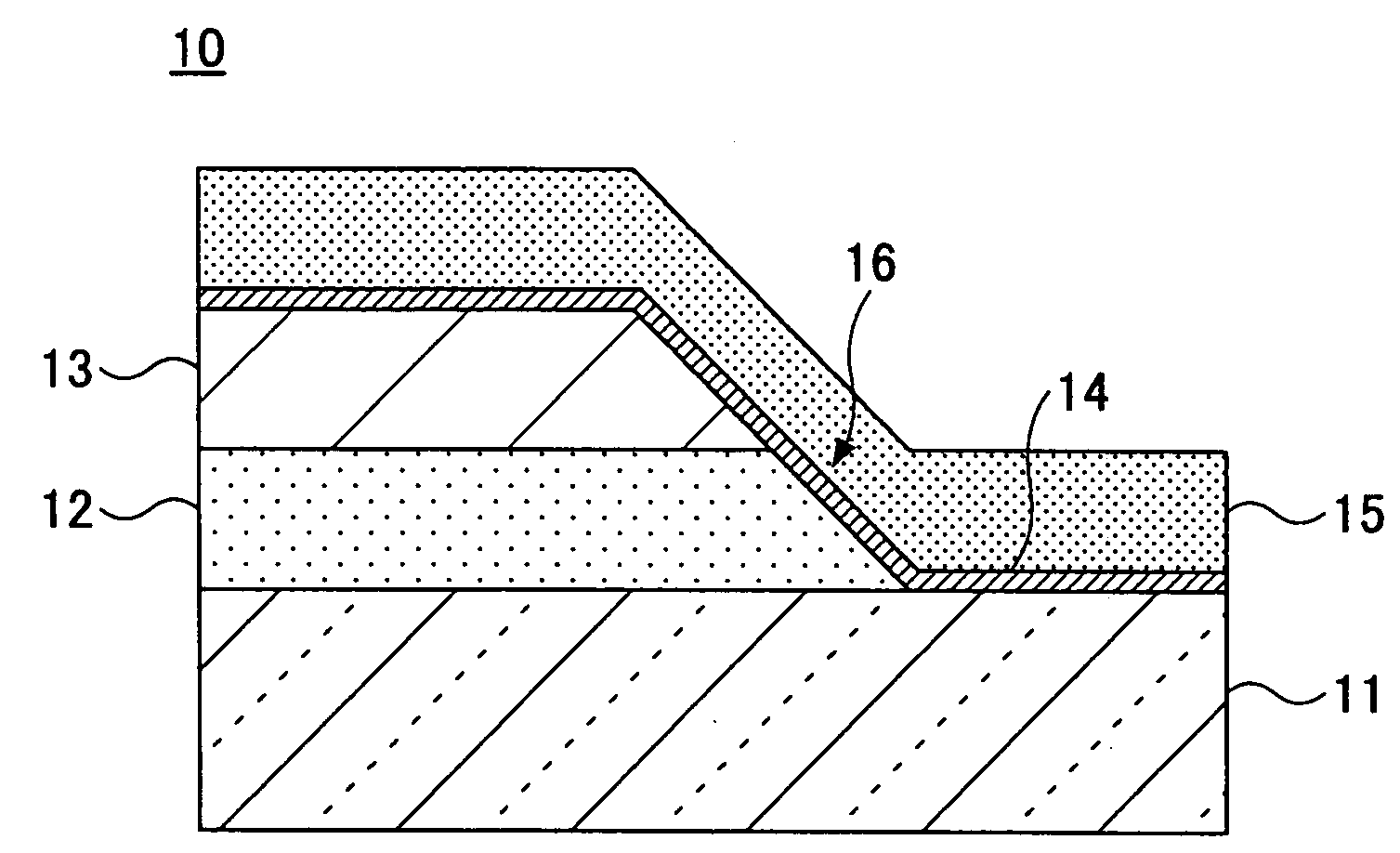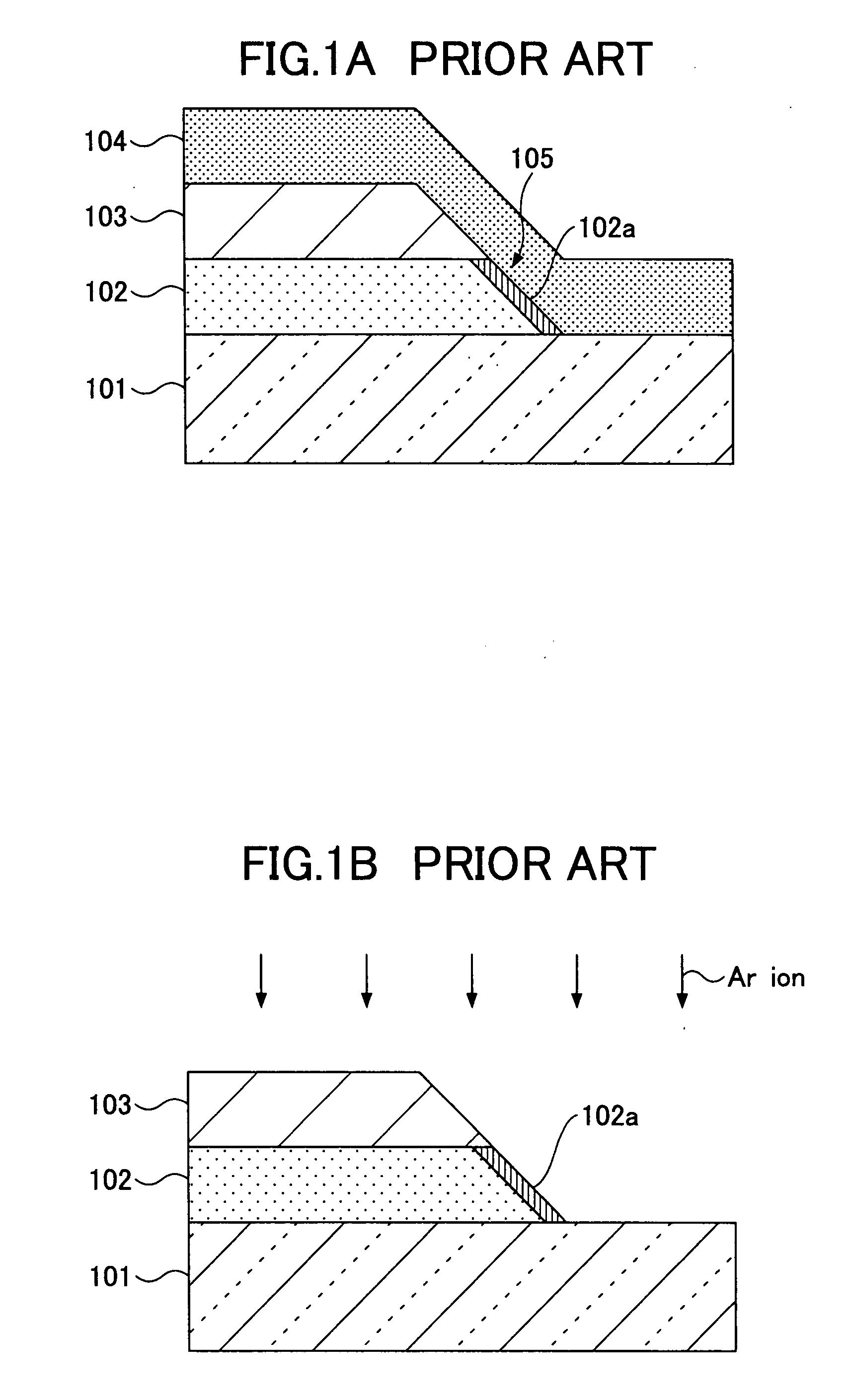Josephson device, method of forming Josephson device and superconductor circuit
a superconductor circuit and a technology of josephson devices, applied in the direction of superconductors/hyperconductors, semiconductor devices, semiconductor/solid-state device details, etc., can solve the problems of not being able to obtain a sufficiently large icrn product, only forming bi-crystal-type junctions, and unsuitable for high-performance devices that require complex structures. , to achieve the effect of suppressing current leakage, avoiding damag
- Summary
- Abstract
- Description
- Claims
- Application Information
AI Technical Summary
Benefits of technology
Problems solved by technology
Method used
Image
Examples
first embodiment
[0038]FIG. 2 is a cross sectional view showing a Josephson device in a first embodiment of the present invention.
[0039]A Josephson device 10 of the first embodiment shown in FIG. 2 has the ramp-edge structure. The Josephson device 10 has a substrate 11, a lower electrode layer 12 formed on the substrate 11, an insulator layer 13 covering the lower electrode layer 12, a barrier layer 14, and an upper electrode layer 15 covering the barrier layer 14. The barrier layer 14 covers a surface of the substrate 11, a sloping surface formed at one end of each of the lower electrode layer 12 and the insulator layer 13, and a surface of the insulator layer 13. A superconducting junction 16 is formed by the lower electrode layer 12, the barrier layer 14 and the upper electrode layer 15.
[0040]The substrate 11 is made of a material having a crystal structure that allows epitaxial growth of the lower electrode layer 12 on the substrate 11. For example, the substrate 11 may be made of a material sel...
embodiment sample emb1-1
[0072]Embodiment samples Emb1-1 were formed to have the same structure as the Josephson device 10 shown in FIG. 2 including the barrier layer 14 formed by the ramp-edge type deposition layer.
[0073]First, a YBa2Cu3Oy layer was formed, as a lower electrode layer, on a MgO substrate to a thickness of 200 nm by magnetron sputtering using a YBa2Cu3Oy target, at a substrate temperature of 740° C., an Ar+10 Vol. % O2 atmosphere, and a pressure of 80 mTorr, where Vol. % denotes volume percent. Then, a SrSnO3 layer was formed, as an insulator layer, on the lower electrode layer to a thickness of 250 nm by magnetron sputtering using a SrSnO3 target, at a substrate temperature of 680° C., an Ar+50 Vol. % O2 atmosphere, and a pressure of 50 mTorr.
[0074]Thereafter, the lower electrode layer and the insulator were etched by Ar ions using as a mask a resist layer having an opening formed by photolithography in a region where a superconducting junction is to be formed, so as to form a sloping surfa...
embodiment sample emb1-2
[0093]Embodiment samples Emb1-2 were formed using targets having the same compositions as those used when forming the embodiment samples Emb1-1, except for the barrier layer and the upper electrode layer, so as to obtain Josephson devices including a ramp-edge type barrier layer that is a deposited layer.
[0094]The barrier layer was formed on the substrate, the sloping surface portion of the lower electrode layer, and the sloping surface portion and the surface of the insulator layer to a thickness of 1.5 nm by PLD, using a YBa2Cu3Oy target, at a laser irradiation energy of 450 mJ / cm2, an oxygen atmosphere, a pressure of 50 mTorr, and a substrate-target distance of 80 mm.
[0095]In addition, the upper electrode layer was formed on the barrier layer to a thickness of 200 nm by magnetron sputtering, using a YBa2Cu3Oy target, at a substrate temperature of 660° C., an oxygen atmosphere, and a pressure of 200 mTorr.
[0096]By carrying out a patterning process, 16 Josephson devices were formed...
PUM
| Property | Measurement | Unit |
|---|---|---|
| diameter | aaaaa | aaaaa |
| critical temperature | aaaaa | aaaaa |
| temperatures | aaaaa | aaaaa |
Abstract
Description
Claims
Application Information
 Login to View More
Login to View More - R&D
- Intellectual Property
- Life Sciences
- Materials
- Tech Scout
- Unparalleled Data Quality
- Higher Quality Content
- 60% Fewer Hallucinations
Browse by: Latest US Patents, China's latest patents, Technical Efficacy Thesaurus, Application Domain, Technology Topic, Popular Technical Reports.
© 2025 PatSnap. All rights reserved.Legal|Privacy policy|Modern Slavery Act Transparency Statement|Sitemap|About US| Contact US: help@patsnap.com



